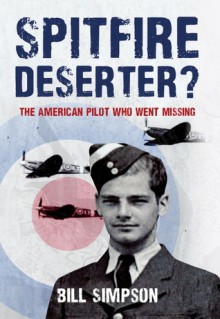
I was prompted recently to buy the book "SPITFIRE DESERTER?" because of a story I had come across years ago from reading the book 'Malta: The Spitfire Year 1942' about an American fighter pilot flying Spitfires with the Royal Air Force (RAF) who was regarded as a deserter because he was the only pilot of his squadron to fly off the American carrier USS Wasp on the morning of April 20, 1942 to the besieged Mediterranean island of Malta who failed to arrive there.
Indeed, "Malta: The Spitfire Year 1942" states that "[at] 1117 [on April 20, 1942] , a message was received from Malta that 46 aircraft had arrived safely, and that one was missing. This was the aircraft flown by one of 603 Squadron's Americans, Sgt. Walcott, who had been with the unit for only a month. He had confided to a Canadian pilot that he had no intention of flying to Malta. Consequently, as the Spitfires began their 660-mile flight, he turned for Algeria (some 55 miles to the south) where he force-landed BP958 in the area to the south of the Atlas mountains. Making contact with the US Consulate, he claimed to be a lost civilian pilot in need of repatriation!"
Well, in "Spitfire Deserter", Bill Simpson provides the reader with some background history about Salvatore "Bud" Walcott, his flight training with the Royal Canadian Air Force (RCAF) in Canada and the advanced flight training he received during 1941-42 with the RAF in Britain. To his credit, Simpson makes an earnest attempt to determine -- given what information he was able to obtain about Walcott from U.S. and British sources, as well as from former squadron mates and people in Massachusetts (where Walcott lived for most of his life, dying there in July 1962, age 42) --- whether or not, as has been alleged by the RAF authorities, "Bud" Walcott was a deserter and a defector.
From what I read, I don't know what can conclusively be said to account for Walcott's failure to reach Malta in April 1942. Walcott himself claimed that shortly after taking off from the USS Wasp, his Spitfire could barely sustain airspeed to remain aloft. So he increased power to his aircraft's engine and was able to gain altitude. But by that time, he was lagging behind his squadron mates. He increased power as a way to catch up with the formation, but became concerned that he might exhaust his fuel prematurely. After all, he had more than 600 miles to fly over the sea --- most of it deep in enemy territory. So, Walcott dropped down to sea level, endeavoring to independently make it to Malta. Some time later, Walcott passes over a small white ship and noticed black smoke coming out of his engine exhaust. His cockpit filled with smoke and the engine temperature began to rise alarmingly. What to do? Walcott thought he might have to bail out and so climbed to what he regarded as a safe altitude for doing so. He was now at 1,200 feet and headed toward the Algerian coast. (Algeria was then a part of French North Africa which was administered by Vichy France, a client state of Nazi Germany set up shortly after France's surrender to Germany in June 1940.) The engine temperature of Walcott's Spitfire had at this point returned to a normal range. But once over Algeria, the engine cut out and Walcott had no choice but to try to make a landing as soon as possible. His Spitfire crash landed and Walcott was knocked unconscious by the impact. Subsequently, he was picked up by Vichy authorities and placed in an internment camp on the edge of the Sahara Desert where conditions were austere, at times brutal, and harsh. There Walcott would remain as a de facto prisoner til the Allied invasion of North Africa in November 1942, when he was freed and repatriated to Britain, where he made a report about what he had been through since he had been reported as missing. Subsequently, Walcott would be commissioned as an officer in the U.S. Army Air Force (USAAF), fly combat with a fighter squadron in North Africa, and later be sent back to the U.S., where served out the remainder of the war as a flight instructor.
In my view, given the scope of information the author was able to obtain about Walcott and the matter of determining whether or not he was a deserter while with the RAF, the book could have been much shorter. There were so many fillers about the part of Massachusetts in which Walcott grew up, the history of the affluent family into which he married while with the USAAF, and a short history of the island of Malta and its significance during the Second World War as key to Britain's strategic position in the Mediterranean. What I found useful in understanding who Wolcott was through learning about the extensive flight training he received as a fighter pilot, as well as the treatment he and other Allied combatants received during his internment at Laghouat by the Vichy authorities. Hence, the 2 stars.


 Log in with Facebook
Log in with Facebook 









